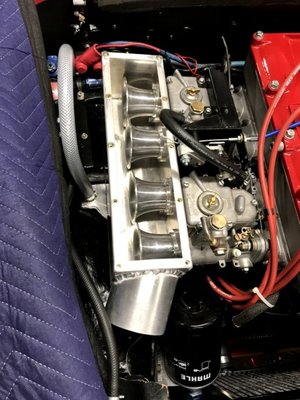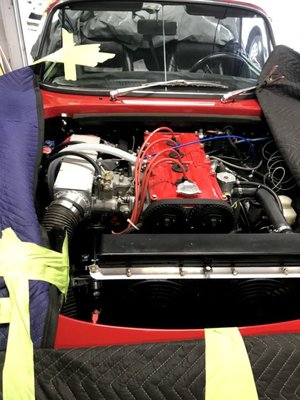Airhorn/rampipe tabs with airbox?
20 posts
• Page 2 of 2 • 1, 2
This topic had me thoroughly confused for several messages until I realised that in America you are using the name air horn for something completely different than my knowledge.
In the UK an air horn is typically a device with a compressor and horn(s) intended to make a loud noise when you press the button at the centre of the steering wheel.

Whereas the tubes that feed air into a carburettor (which is what you are talking about) are usually called air trumpets in the UK

The Lotus parts list calls them trumpets. http://www.lotuselan.net/wiki/EG_-_Engi ... arburetter
~~~~
I'm not complaining, just noting yet another difference between American English and UK English language.

In the UK an air horn is typically a device with a compressor and horn(s) intended to make a loud noise when you press the button at the centre of the steering wheel.

Whereas the tubes that feed air into a carburettor (which is what you are talking about) are usually called air trumpets in the UK

The Lotus parts list calls them trumpets. http://www.lotuselan.net/wiki/EG_-_Engi ... arburetter
~~~~
I'm not complaining, just noting yet another difference between American English and UK English language.
Bill Williams
36/6725 S3 Coupe OGU108E Yellow over Black.
36/6725 S3 Coupe OGU108E Yellow over Black.
- billwill
- Coveted Fifth Gear

- Posts: 4417
- Joined: 19 Apr 2008
Kyle,
Just as a 'for what its worth' airflow into a carb trumpet is a complex thing.
Vizard did some studies, and a significant amount of air comes from behind the trumpet and over the lip. Equally the clearance from the trumpet mouth to the facing airbox wall is important. There are a number of threads on the subject, but the advice was to leave at least 1.6 inches from the mouth of the trumpet to the facing airbox wall.
Given Vizard's work, it also looks a good idea to leave a decent clearance above and below the trumpet to allow air to flow from behind.
Good luck.
Just as a 'for what its worth' airflow into a carb trumpet is a complex thing.
Vizard did some studies, and a significant amount of air comes from behind the trumpet and over the lip. Equally the clearance from the trumpet mouth to the facing airbox wall is important. There are a number of threads on the subject, but the advice was to leave at least 1.6 inches from the mouth of the trumpet to the facing airbox wall.
Given Vizard's work, it also looks a good idea to leave a decent clearance above and below the trumpet to allow air to flow from behind.
Good luck.
68 Elan S3 HSCC Roadsports spec
71 Elan Sprint (still being restored)
32 Standard 12
Various modern stuff
71 Elan Sprint (still being restored)
32 Standard 12
Various modern stuff
- Andy8421
- Coveted Fifth Gear

- Posts: 1226
- Joined: 27 Mar 2011
Thanks Andy,
Quaterbacking on a Monday?
I've read Vizard's books going back 30 years. I've also made quite a few airboxs before.
I left as much space as could be afforded. The ends of the airhorns are 1.5" from the opposing wall. I've worked on 500hp 3.5l NA motors were there was less than 1" from the opposing wall. I'm not saying that was optimal, but reality is what it is. That car won a lot of championships.
As you know, in an Elan there is precious little space under the airhorns. So that facet of the bell is necessarily close to the floor of the airbox. The rear facet of the #4 is also close to the rear wall. I could have shaped the box differently to get more space there, but it wasn't worth it. These are very large diameter bells and thus likely less affected by the proximity of the walls than a stock Weber airhorn.
The old setup with the tapered (front to back and top to bottom) Elan airbox had the #4 airhorn less than 1/4" from the lower rear corner of the airbox. With that setup this car could spin the tires in all four gears.
This is a massive improvement and will give 99.9% of the available power from airbox shape.
-Kyle
Quaterbacking on a Monday?
I've read Vizard's books going back 30 years. I've also made quite a few airboxs before.
I left as much space as could be afforded. The ends of the airhorns are 1.5" from the opposing wall. I've worked on 500hp 3.5l NA motors were there was less than 1" from the opposing wall. I'm not saying that was optimal, but reality is what it is. That car won a lot of championships.
As you know, in an Elan there is precious little space under the airhorns. So that facet of the bell is necessarily close to the floor of the airbox. The rear facet of the #4 is also close to the rear wall. I could have shaped the box differently to get more space there, but it wasn't worth it. These are very large diameter bells and thus likely less affected by the proximity of the walls than a stock Weber airhorn.
The old setup with the tapered (front to back and top to bottom) Elan airbox had the #4 airhorn less than 1/4" from the lower rear corner of the airbox. With that setup this car could spin the tires in all four gears.
This is a massive improvement and will give 99.9% of the available power from airbox shape.
-Kyle
'70 S4 Elan - Cosworth BDP & Spyder Chassis
'62 S2 Super Seven Cosworth
'62 S2 Super Seven Cosworth
- disquek
- Second Gear

- Posts: 151
- Joined: 25 Oct 2018
20 posts
• Page 2 of 2 • 1, 2
Total Online:
Users browsing this forum: No registered users and 9 guests


